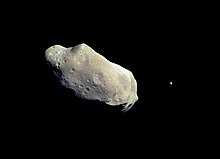Księżyc planetoidy
Księżyce planetoid lub moonletki (ang. moonlets) – naturalne satelity planetoid. Są to mniejsze planetoidy, obiegające wraz z większym ciałem wspólny środek masy. O tym, czy dane ciało może uchodzić za „księżyc” jakiejś planetoidy, decyduje stosunek rozmiarów obydwu składników układu. Jeśli ciała są zbliżone rozmiarami, uważa się taki układ za planetoidę podwójną.
We wrześniu 2022 znanych było 470 planetoid i obiektów transneptunowych z księżycami (w tym też podwójnych planetoid). Są wśród nich ciała z różnych grup – planetoidy bliskie Ziemi, obiekty głównego pasa planetoid, trojańczycy i obiekty z pasa Kuipera[1]. Ciała te mają rozmiary do kilkunastu czy kilkudziesięciu kilometrów, w przypadku planetoid z pasa głównego, do nawet kilkuset kilometrów w przypadku obiektów transneptunowych[1].
Pierwszym bezpośrednio zaobserwowanym naturalnym satelitą planetoidy był Daktyl – księżyc planetoidy Idy, odkryty na zdjęciach sondy Galileo w 1993[2]. Wiele księżyców planetoid zostało odkrytych metodą pośrednią, w wyniku analizy krzywych zmian jasności tych ciał niebieskich. Niektóre planetoidy mają więcej niż jeden księżyc, rekordzistką jest (130) Elektra, którą okrążają trzy znane księżyce[3]. Niektóre obiekty mają też pierścienie, pierwszy taki system odkryto wokół (10199) Chariklo[4].
Dimorphos, księżyc planetoidy (65803) Didymos, był przedmiotem pierwszego testu obrony planetarnej. We wrześniu 2022 roku amerykańska sonda DART zderzyła się z tym księżycem, zmieniając jego orbitę wokół głównego składnika[5].
Zobacz też
Przypisy
- ↑ a b Wm. Robert Johnston: Asteroids with Satellites. Johnston’s Archive, 2022-09-10. [dostęp 2022-09-28]. (ang.).
- ↑ Ida and Dactyl, NASA [dostęp 2022-09-28] (ang.).
- ↑ Marcin Powęska: Pierwsza taka detekcja w historii. Odkryto układ poczwórny planetoid. GeekWeek INTERIA, 2022-02-19. [dostęp 2022-02-19].
- ↑ F. Braga-Ribas et al.. A ring system detected around the Centaur (10199) Chariklo. „Nature”, 2014-03-26. DOI: 10.1038/nature13155. (ang.).
- ↑ Josh Handal, Justyna Surowiec, Michael Buckley: NASA’s DART Mission Hits Asteroid in First-Ever Planetary Defense Test. NASA, 2022-09-27. [dostęp 2022-09-27]. (ang.).
Media użyte na tej stronie
This is a revised version of Solar_System_XXIX.png.
This color picture is made from images taken by the imaging system on the Galileo spacecraft about 14 minutes before its closest approach to asteroid 243 Ida on August 28, 1993, at a distance of about 10,500 kilometers (6,500 miles). The images used are from the sequence in which Ida's moon was originally discovered; the moon is visible to the right of the asteroid. This picture is made from images through the 4100-ångström (violet), 7560 Å (infrared) and 9680 Å (infrared) filters. The color is 'enhanced' in the sense that the CCD camera is sensitive to near-infrared wavelengths of light beyond human vision; a 'natural' color picture of this asteroid would appear mostly gray. Shadings in the image indicate changes in illumination angle on the many steep slopes of this irregular body as well as subtle color variations due to differences in the physical state and composition of the soil (regolith). There are brighter areas, appearing bluish in the picture, around craters on the upper left end of Ida, around the small bright crater near the center of the asteroid, and near the upper right-hand edge (the limb). This is a combination of more reflected blue light and greater absorption of near infrared light, suggesting a difference in the abundance or composition of iron-bearing minerals in these areas. Ida's moon also has a deeper near-infrared absorption and a different color in the violet than any area on this side of Ida. The moon is not identical in spectral properties to any area of Ida in view here, though its overall similarity in reflectance and general spectral type suggests that it is made of the same rock types basically. These data, combined with study of further imaging data and more detailed spectra from the Near Infrared Mapping Spectrometer, may allow scientists to determine whether the larger parent body of which Ida, its moon, and some other asteroids are fragments was a heated, differentiated object or made of relatively unaltered primitive chondritic material.
Asteroid Didymos (bigger/nearer one) and its moonlet, Dimorphos, about 2.5 minutes before the impact of NASA’s DART spacecraft. The image was taken by the on board DRACO imager from a distance of 570 miles (920 kilometers). This image was the last to contain a complete view of both asteroids. Didymos is roughly 2,500 feet (780 meters) in diameter; Dimorphos is about 525 feet (160 meters) in length. Ecliptic north is toward the bottom of the image. This image is shown as it appears on the DRACO detector and is mirror flipped across the x-axis from reality.
Cassini color image of Rhea, showing the wispy trailing hemisphere.






